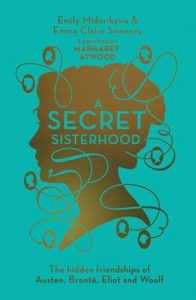 I’m delighted to be part of the Blog Tour for the paperback edition of A Secret Sisterhood: The hidden friendships of Austen, Brontë, Eliot and Woolf published by Aurum Press and out March 1st. It is one of those books from which you absorb information without realising it. With a forward from Margaret Atwood, it’s a manifesto for female literary friendship.
I’m delighted to be part of the Blog Tour for the paperback edition of A Secret Sisterhood: The hidden friendships of Austen, Brontë, Eliot and Woolf published by Aurum Press and out March 1st. It is one of those books from which you absorb information without realising it. With a forward from Margaret Atwood, it’s a manifesto for female literary friendship.
Emily Midorikawa and Emma Claire Sweeney have been interested in literary female friendship for some time. Not believing that the famous male literary friendships, like Coleridge and Wordsworth or F. Scott Fitzgerald and Ernest Hemingway, had no female counterparts, A Secret Sisterhood is the culmination of a journey begun in 2014 with Emily and Emma’s Something Rhymed project which celebrates a whole host of different female author pairings.
The idea of Something Rhymed and A Secret Sisterhood is to unveil and celebrate female literary friendships. A Secret Sisterhood looks at four celebrated writers, Jane Austen, Charlotte Brontë, George Eliot and Virginia Woolf, and uncovers the female literary friendships that have previously been obscured or misunderstood by biographers. Where letters were destroyed to maintain propriety—as in the case of Austen’s friendship with Anne Sharp, whose lower social standing made her a friend Austen’s family would rather have you forget—Emily and Emma delve into secondary sources to create a picture of these relationships that allows the reader to imagine being in their shoes.
Not only are they providing new avenues of scholarship, Emily and Emma are also keen to recreate the sense of what it was to live in these earlier times of uncomfortable carriage rides and a general belief that women’s creative energies belonged in the domestic sphere and most importantly in childbirth. The image of the female writer as social outcast is one Margaret Atwood speaks of in her introduction to the book, and one which A Secret Sisterhood does much to challenge.
We may think of Austen and Charlotte Brontë as homely creatures, but Austen was happy to talk literature with her niece’s governess and Charlotte Brontë held adventurer and feminist Mary Taylor as one of her dearest friends and critics. It’s hard to imagine George Eliot being sentimental and yet her friendship with Harriet Beecher Stowe, despite various differences of belief, reveals a softer edge to her character. Similarly, the famously barbed and suicidal Virginia Woolf, through her difficult relationship with Katherine Mansfield (which is usually written off as embittered rivalry), is seen to be someone who deeply valued the challenge and inspiration Katherine brought to her work.
A Secret Sisterhood allowed me to walk alongside these famous writers, imagining their thoughts and feelings, sensing the pressure of the cobbles beneath their feet. A Secret Sisterhood is an earnest manifesto for female literary friendship, using the past to remind us that women writers are still fighting to be taken as seriously as their male counterparts and one way to win that fight is to work together.
 On that theme, do take a look at the rest of the blog tour for the book and you might also be interested in the new direction that Something Rhymed is now taking. Emma and Emily are offering some great opportunities for female writers. You can find out more on their website here.
On that theme, do take a look at the rest of the blog tour for the book and you might also be interested in the new direction that Something Rhymed is now taking. Emma and Emily are offering some great opportunities for female writers. You can find out more on their website here.
I’ll be reviewing Homegoing by Yaa Gyasi later this week.